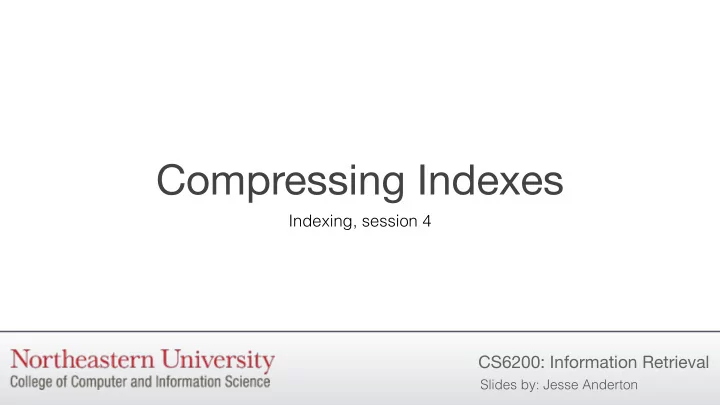

Compressing Indexes Indexing, session 4 CS6200: Information Retrieval Slides by: Jesse Anderton
Index Size Inverted lists often consume a large amount of space. • e.g., 25-50% of the size of the raw documents for TREC collections with the Indri search engine • much more than the raw documents if n-grams are indexed Compressing indexes is important to conserve disk and/or RAM space. Inverted lists have to be decompressed to read them, but there are fast, lossless compression algorithms with good compression ratios.
Entropy and Compressibility The entropy of a probability distribution is a measure of its randomness. � H ( p ) = − p i log p i i The more random a sequence of data is, the less predictable and less compressible it is. The entropy of the probability distribution of a data sequence provides a bound on the best possible compression ratio. Entropy of a Binomial Distribution
Hu ff man Codes In an ideal encoding scheme, a symbol 𝔽 [ length ] p i Symbol Code with probability p i of occurring will be a 1/2 0 0.5 assigned a code which takes log( p i ) bits. b 1/4 10 0.5 The more probable a symbol is to occur, the smaller its code should be. By this c 1/8 110 0.375 view, UTF-32 assumes a uniform distribution over all unicode symbols; d 1/16 1110 0.25 UTF-8 assumes ASCII characters are more e 1/16 1111 0.25 common. Huffman Codes achieve the best possible Plaintext: aedbbaae (64 bits in UTF-8) compression ratio when the distribution is Ciphertext: 0111111101010001111 known and when no code can stand for multiple symbols.
Building Hu ff man Codes Huffman Codes are built using a binary tree 1 which always joins the least probable 1 remaining nodes. 1/2 1. Create a leaf node for each symbol, weighted by its probability. 1 0 2. Iteratively join the two least probable 1/4 nodes without a parent by creating a 0 1 parent whose weight is the sum of the childrens’ weights. 0 1/8 3. Assign 0 and 1 to the edges from each 0 1 parent. The code for a leaf is the sequence of edges on the path from the a: 1/2 b: 1/4 d: 1/16 c: 1/8 e: 1/16 root. 0 10 110 1110 1111
Can We Do Better? Huffman codes achieve the theoretical limit for compressibility, assuming that the size of the code table is negligible and that each input symbol must correspond to exactly one output symbol. Other codes, such as Lempel-Ziv encoding, allow variable-length sequences of input symbols to correspond to particular output symbols and do not require transferring an explicit code table. Compression schemes such as gzip are based on Lempel-Ziv encoding. However, for encoding inverted lists it can be beneficial to have a 1:1 correspondence between code words and plaintext characters.
Wrapping Up The best any compression scheme can do depends on the entropy of the probability distribution over the data. More random data is less compressible. Huffman Codes meet the entropy limit and can be built in linear time, so are a common choice. Other schemes can do better, generally by interpreting the input sequence differently (e.g. encoding sequences of characters as if they were a single input symbol – different distribution, different entropy limit). Next, we’ll take a look at how to efficiently represent integers of arbitrary size using bit-aligned codes.
Recommend
More recommend